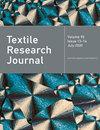The investigation on dark dyeing properties of silk using Dioscorea cirrhosa Lour. tuber extracts with varied molecular weights
IF 1.9
4区 工程技术
Q2 MATERIALS SCIENCE, TEXTILES
引用次数: 0
Abstract
This work reported the dark dyeing properties of Dioscorea cirrhosa Lour. tuber extracts with different molecular weights on silk. The study on component analysis indicates that the molecular weight of most condensed tannins and polyphenols in D. cirrhosa L. tuber extracts is higher than 1000. The kinetic study demonstrates that the adsorption processes of D. cirrhosa L. tuber extract components with molecular weights higher than 1000, and components with molecular weights lower than 1000 toward silk fabrics are fitted with the pseudo-second order model, and the survey of adsorption isotherms reveals that multiple interactions occurred between dyes and silk, encompassing hydrogen bonding and van der Waals forces. The dyeing research shows that the dyed silk achieves its darkest color when employing D. cirrhosa L. tuber extract components with molecular weights lower than 1000 with a Fe使用不同分子量的薯蓣块茎提取物对丝绸深色染色性能的研究
本研究报告了不同分子量的薯蓣块茎提取物对蚕丝的深色染色特性。成分分析表明,薯蓣块茎提取物中大多数缩合单宁和多酚的分子量大于 1000。动力学研究表明,D. cirrhosa L. 块茎提取物中分子量大于 1000 的成分和分子量小于 1000 的成分对丝织物的吸附过程符合伪二阶模型,吸附等温线的调查表明,染料和丝绸之间存在多种相互作用,包括氢键和范德华力。染色研究表明,当采用分子量小于 1000 的 D. cirrhosa L. 块茎提取物成分,Fe2+媒染剂浓度为 4 g/L,pH 值为 5 时,染色丝的颜色最深。染色丝绸的 K/S 值和 L* 值分别为 9.05 和 30.77。在此染色条件下,用分子量小于 1000 表层的 D. cirrhosa L. 块茎提取物成分染色的丝绸上的络合物、铁元素含量和 Fe2+ 比值均高于 D. cirrhosa L. 块茎提取物和分子量大于 1000 表层的 D. cirrhosa L. 块茎提取物成分。本研究表明,D. cirrhosa L. 块茎提取物中的缩合单宁不是参与丝绸深色染色过程的唯一活性化合物。研究表明,D. cirrhosa L. 块茎提取物中分子量低于 1000 的多酚对丝绸深色染色过程有显著影响,在某些情况下甚至起主导作用。
本文章由计算机程序翻译,如有差异,请以英文原文为准。
求助全文
约1分钟内获得全文
求助全文
来源期刊

Textile Research Journal
工程技术-材料科学:纺织
CiteScore
4.00
自引率
21.70%
发文量
309
审稿时长
1.5 months
期刊介绍:
The Textile Research Journal is the leading peer reviewed Journal for textile research. It is devoted to the dissemination of fundamental, theoretical and applied scientific knowledge in materials, chemistry, manufacture and system sciences related to fibers, fibrous assemblies and textiles. The Journal serves authors and subscribers worldwide, and it is selective in accepting contributions on the basis of merit, novelty and originality.
 求助内容:
求助内容: 应助结果提醒方式:
应助结果提醒方式:


